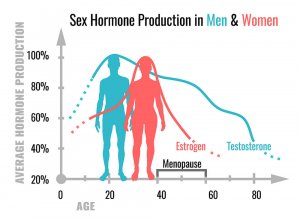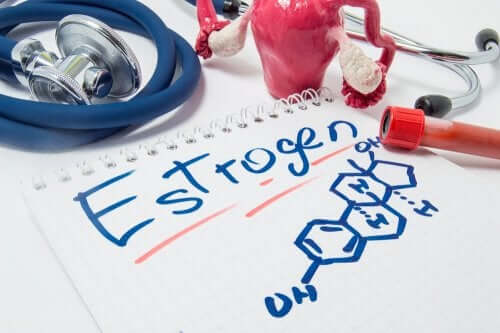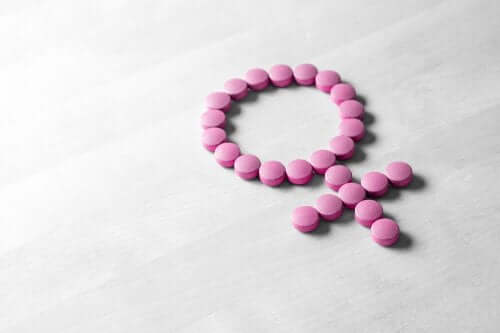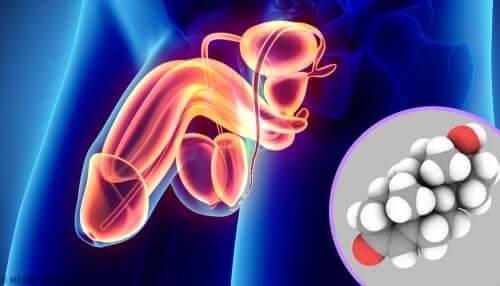What Do Sex Hormones Do?

Sex hormones are chemical substances synthesized in the sex organs. In the ovary, in the case of women, or in the testicles, in the case of men.
Their synthesis is directly dependent on the action of another hormone, GnRH, in the hypophysis (pituitary gland), which at the same time secretes gonadotropins. These are, in the end, in charge of stimulating either the testicle or the ovary.
The precursor to sex hormones is cholesterol, which is differentiated in the male and female sex hormones. These hormones can be made to improve the quality of life of patients with illnesses like breast or prostate cancer, or fertility and uterine dynamics.
Among the female sex hormones, there are estrogens and progestogens, both produced in the ovaries. As for the male sex hormones, there are androgens, produced in the testicles.
Female sex hormones
Estrogen

Estrogens are in charge of differentiating the female secondary sex characteristics. They are also in charge of controlling the menstrual cycle and facilitating bone growth in women.
When they are separated, the creation of progesterone receptors in the uterus increases. This facilitates a series of actions that we’ll explain later.
Estrogens also participate in metabolic and cardiovascular functions, since they retain sodium, salt, and water. The retention of sodium has consequences in women with menopause since, being so absorbent, they can cause loss of bone mass. Due to this, many women need to seek hormone therapy.
When a person undergoes treatment with a high dose of estrogens, these sex hormones act as contraceptives, in addition to:
- Lowering glucose tolerance
- Increasing production of coagulation factors and plasminogen and decreasing production of prothrombin III, which increases the risk of blood clots
- Increasing the production of renin and angiotensin, and helping the release of aldosterone. You should keep an eye on your blood pressure, since its value can change due to these factors.
You might be interested in: 4 Easy Tips to Boost Fertility
Progestogens or gestagens

As we mentioned before, the release of estrogens immediately causes the number of progesterone receptors to increase, which facilitates interaction between the two.
When progesterone reaches its receptors, the direct consequence is that it reduces the number of couplings between estrogen and its receptors. This is a good thing, since progesterone helps avoid endometrial hyperplasia.
As we mentioned, estrogens are the sexual hormones in charge of female secondary sex characteristics, like the uterus. Due to this, if the estrogens keep up their activity or increase, you can develop endometrial hyperplasia.
In this way, the gestagens transform the estrogenic endometrium into a secretory endometrium.
On the other hand, progesterone is the sex hormone that prepares the uterus for pregnancy. Thus, when progesterone levels drop, menstruation starts. It also helps breast milk production.
Unlike estrogens, this hormone blocks aldosterone receptors. Additionally, during ovulation, it increases the body temperature by 0.5ºC (about 0.9ºF).
Read also: Erectile Dysfunction: From Diagnosis to Treatment
Male sex hormones
Androgens

Androgens have masculinizing effects. They facilitate the development of male genitals and of secondary sex characteristics. On the other hand, synthetic androgens can be used to treat illnesses like:
- Male hypogonadism
- Anemia: they increase the production of erythropoietin in the kidney due to its anabolic action
- Breast carcinoma: in refractory cases and other treatments as an adjuvant
- Anorexia
The anabolic action is because they increase the production of proteins, which increases muscle mass.
Among the functions of sex hormones we can find the stimulation of sperm production in the seminiferous tubules. In addition, they facilitate maturation of spermatid in the sperm.
They also promote the growth of the penis, scrotum, and secretory sexual glands, as well as the testicles. Finally, they increase the growth of pubic hair and libido, that is, sexual desire.
https://mejorconsalud.as.com/cuales-funciones-hormonas-sexuales/
All cited sources were thoroughly reviewed by our team to ensure their quality, reliability, currency, and validity. The bibliography of this article was considered reliable and of academic or scientific accuracy.
- Soediono, B. (1989). HORMONAS SEXUALES. Journal of Chemical Information and Modeling. https://doi.org/10.1017/CBO9781107415324.004
- Guyton, A., & Hall, J. (2011). Fisiología femenina antes del embarazo y hormonas femeninas. In Guyton & Hall: Tratado de fisiologia médica.
- Barañao, R. I. (2009). Hormonas sexuales y respuesta inmunológica. Saegre.
-
Cachofeiro, V. (2009). Alteraciones del colesterol y enfermedad cardiovascular. Lopez Farré A., Macaya Miguel C. et al Libro de la salud cardiovascular. 1ª ed. Bilbao: Fundación BBVA, 131-139.
-
García Ayala, E., Cárdenas Mastrascusa, L., Sandoval Martínez, D., & Mayorga Anaya, H. (2010). Hiperplasia endometrial: análisis de serie de casos diagnosticados en biopsia endometrial. Revista chilena de obstetricia y ginecología, 75(3), 146-152.
-
Amado, J. A., & Flórez, J. (2003). Hormonas sexuales: estrógenos, gestágenos, andrógenos y anticonceptivos hormonales. Farmacología humana. 4ª Ed. Barcelona: Masson, p887-912.
-
Brito, C. (2014). Regulación de la eritropoyesis. Facultad de medicina de la Universidad de Chile, 2.
This text is provided for informational purposes only and does not replace consultation with a professional. If in doubt, consult your specialist.








